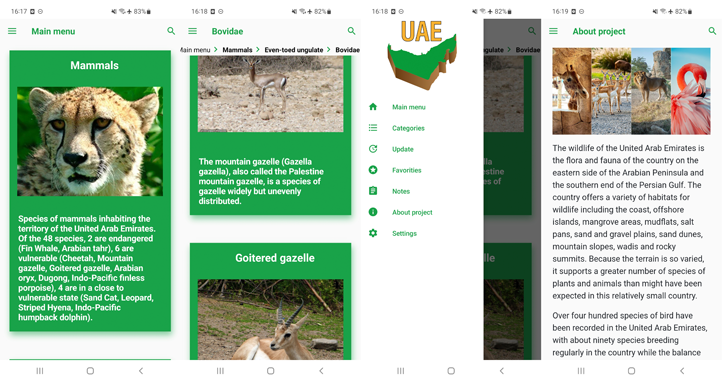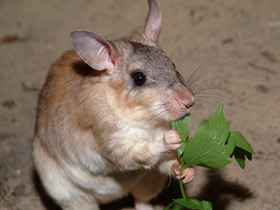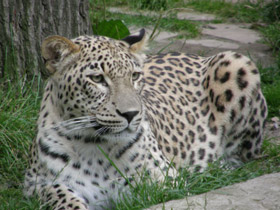Application «Emirates animals»



The wildlife of the United Arab Emirates is the flora and fauna of the country on the eastern side of the Arabian Peninsula and the southern end of the Persian Gulf. The country offers a variety of habitats for wildlife including the coast, offshore islands, mangrove areas, mudflats, salt pans, sand and gravel plains, sand dunes, mountain slopes, wadis and rocky summits. Because the terrain is so varied, it supports a greater number of species of plants and animals than might have been expected in this relatively small country.
Over four hundred species of bird have been recorded in the United Arab Emirates, with about ninety species breeding regularly in the country while the balance are winter visitors, migrants or vagrants. The country is on the crossroads of two major migratory routes, one between the Palaearctic and Africa, the other between the Near East and the Indian subcontinent, and the migrants make use of the many types of habitat available.
About 250,000 waders visit the Gulf shores and mudflats at peak migration time; these include the grey plover (Pluvialis squatarola), the greater (Charadrius leschenaultii) and lesser (Charadrius mongolus) sand plovers, the crab plover (Dromas ardeola), the Kentish plover (Charadrius alexandrinus) and the broad-billed sandpiper (Calidris falcinellus). The coast, and particularly offshore islands are used by many seabirds. About twenty to thirty percent of the world's Socotra cormorants (Phalacrocorax nigrogularis), about 200,000 birds, breed in the United Arab Emirates. Sooty gulls (Ichthyaetus hemprichii) breed here, as do red-billed tropicbirds (Phaethon aethereus) as well as several species of tern; white-cheeked (Sterna repressa), bridled (Onychoprion anaethetus) and lesser crested tern (Thalasseus bengalensis).
Waters of the Persian Gulf along Abu Dhabi holds the world's largest population of Indo-Pacific humpbacked dolphins.
A large number of passerine birds breed in the deserts, salt flats, plains, dunes and mountains. Twelve species of wheatear have been recorded in the country as well as warblers (Sylviidae), babblers (Timaliidae), rollers (Coraciidae), bulbuls (Pycnonotidae), the desert lark (Ammomanes deserti) and many others. The sooty falcon (Falco concolor) overwinters in Madagascar and breeds in the United Arab Emirates. Other than this, there are only a small number of raptor species; Bonelli's eagle, barbary falcon, short-toed snake eagle, long-legged buzzard and lappet-faced vulture.
Many of the large mammals found in the Arabian Peninsula were well-adapted to desert life in the harsh terrain, but were wiped out by human hunting in the last hundred years or so. Hunting is now banned in the United Arab Emirates, but feral goats and donkeys are plentiful and graze freely, lessening the chance for the native gazelles to recover from their reduced population sizes. Large terrestrial mammals still found in the United Arab Emirates include the Arabian tahr (Arabitragus jayakari), the Arabian oryx (Oryx leucoryx), the sand gazelle (Gazella marica) and the mountain gazelle (Gazella gazellacora). Carnivores include the Arabian wolf (Canis lupus arabs), the striped hyena (Hyaena hyaena), the red fox, the Blanford's fox (Vulpes cana), the Rüppell's fox (Vulpes rueppellii), the Asiatic caracal (Caracal caracal schmitzi), the Arabian wildcat (Felis lybica lybica), the sand cat (Felis margarita) and formerly the Arabian leopard (Panthera pardus nimr). Other mammals include the Cape hare (Lepus capensis), the Brandt's hedgehog (Paraechinus hypomelas), the desert hedgehog (Paraechinus aethiopicus) and the long-eared hedgehog (Long-eared hedgehog).
Over 54 species of terrestrial reptiles have been recorded in the UAE. These include a large number of lizards, found in all environments from desert, to city, to mountain-top, and a single species of worm lizard (Amphisbaenia). There are thirteen species of terrestrial snake, some of the largest being the sand boa (Erycinae), the saw-scaled viper (Echis) and the horned viper (Cerastes cerastes), and four species of sea snake as well as green sea turtles present in the Persian Gulf (Chelonia mydas). The Ru'us al-Jibal have a gecko of the genus Ptyodactylus named after them. There are two species of amphibian in the United Arab Emirates, the Arabian toad (Sclerophrys arabica) and the Dhofar toad (Duttaphrynus dhufarensis); the former is more commonly seen as the Dhofar toad is nocturnal.
Sharjah's Breeding Centre for Endangered Arabian Wildlife (BCEAW) was established on 1998 and originally built for breeding the threatened wildlife but then has turned to become a center for the research and preservation of the indigenous plants and animals of the region.
You can leave notes and add information to your Favorites. Customize the appearance and select an easy-to-read size of the description text. Automatic check for updates. One—handed operation mode — the ability to change the location of the menu and navigation - at the top or at the bottom. Adaptation of the application for the visually impaired with integration into the "accessibility" settings. The use is as comfortable as possible for reading without stress and fatigue.










































